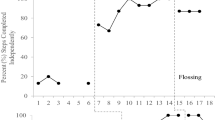Abstract
This study examined the effects of self-directed video prompting presented via an iPod Touch on teaching four adolescents with moderate-to-severe intellectual and developmental disabilities two daily living tasks. Students were taught to wash a table using instructor-delivered video prompts. After reaching 80 % correct for at least three consecutive sessions, a system of most-to-least prompts was used to teach them to use the iPod Touch and a video prompting app (inPromptu) independently. In the final phase, students used inPromptu on the iPod Touch to teach themselves to vacuum with self-directed video prompts. Results of the study demonstrate that all four students learned to wash a table with instructor-directed video prompts, they all learned to use inPromptu on the iPod Touch independently, two students used inPromptu on the iPod Touch to teach themselves to vacuum, and a third student was learning to vacuum using inPromptu.




Similar content being viewed by others
References
Ayers, K. M., Maquire, A., & McClimmon, D. (2009). Acquisition and generalization of chained tasks taught with computer based video instruction to children with autism. Education and Training in Developmental Disabilities, 44, 493–508.
Cannella-Malone, H. I., & Wheaton, J. (2011). inPropmtu (version 1.0) [Computer software]. Columbus, OH: The Ohio State University. Available from http://itunes.apple.com/us/genre/ios/id36?mt=8.
Cihak, D., Alberto, P., Taber-Doughty, T., & Gama, R. (2006). A comparison of static picture prompting and video prompting simulation strategies using group instructional procedures. Focus on Autism and Other Developmental Disabilities, 21, 89–99.
Cihak, D., Fahrenkrog, C., Ayers, K. M., & Smith, C. (2010). The use of video modeling via a video iPod and a system of least prompts to improve transitional behaviors for students with autism spectrum disorders in the general education classroom. Journal of Positive Behavior Interventions, 12, 103–115.
Cooper, J. O., Heron, T. E., & Heward, W. L. (2007). Applied Behavior Analysis (2nd ed.). Upper Saddle River, NJ: Pearson.
Haverman, M., van Berkum, G., Reijnders, R., & Heller, T. (1997). Difference in service needs, time demands, and caregiving burden among parents of persons with mental retardation across the life cycle. Family Relations, 46, 417–425.
Horner, R. D., & Baer, D. M. (1978). Multiple-probe technique: A variation of the multiple baseline. Journal of Applied Behavior Analysis, 11, 189–196.
Jacobson, J. W., & Ackerman, L. J. (1990). Differences in adaptive functioning among people with autism or mental retardation. Journal of Autism and Developmental Disorders, 20, 205–219.
Kagohara, D. M. (2011). Three students with developmental disabilities learn to operate an iPod to access age-appropriate entertainment videos. Journal of Behavioral Education, 20, 33–43.
Kraijer, D. (2000). Review of adaptive behavior studies in mentally retarded persons with autism/pervasive developmental disorder. Journal of Autism and Developmental Disorders, 3, 39–47.
McDougall, D. (1998). Research on self-management techniques used by students with disabilities in general education settings. Remedial and Special Education, 19, 310–329.
Mechling, L. C. (2007). Assistive technology as a self-management tool for prompting students with intellectual disabilities to initiate and complete daily tasks: A literature review. Education and Training in Developmental Disabilities, 42, 252–269.
Mechling, L. C. (2011). Review of twenty-first century portable electronic devices for persons with moderate intellectual disabilities and autism spectrum disorders. Education and Training in Autism and Developmental Disabilities, 46, 476–498.
Mechling, L. C., Gast, D. L., & Fields, E. A. (2008). Evaluation of a portable DVD player and system of least prompts to self-prompt cooking task completion by young adults with moderate intellectual disabilities. The Journal of Special Education, 42, 179–190.
Mechling, L. C., Gast, D. L., & Gustafson, M. R. (2009a). Use of video modeling to teach extinguishing of cooking related fires to individuals with moderate intellectual disabilities. Education and Training in Developmental Disabilities, 44, 67–79.
Mechling, L. C., Gast, D. L., & Seid, N. H. (2009b). Using a personal digital assistant to increase independent task completion by students with autism spectrum disorder. Journal of Autism and Developmental Disorders, 39, 1420–1434.
Mechling, L. C., Gast, D. L., & Seid, N. H. (2010). Evaluation of a personal digital assistant as a self-prompting device for increasing multi-step task completion by students with moderate intellectual disabilities. Education and Training in Autism and Developmental Disabilities, 45, 422–439.
Mechling, L. C., & Stephens, E. (2009). Comparison of self-prompting of cooking skills via picture-based cookbooks and video recipes. Education and Training in Developmental Disabilities, 44, 218–236.
Payne, D. O., Cannella-Malone, H. I., Tullis, C. A., & Sabielny, L. (2012). The effects of self-directed video prompting on the completion of daily living skills for students with moderate to severe intellectual and developmental disabilities. Journal of Developmental and Physical Disabilities, 24, 617–634.
Sigafoos, J., O’Reilly, M. F., Cannella, H., Upadhyaya, M., Edrisinha, C., Lancioni, G. E., et al. (2005). Computer-presented video prompting for teaching microwave oven use to three adults with developmental disabilities. Journal of Behavioral Education, 14, 189–201.
Thomas, A. (1979). Learned helplessness and expectancy factors: Implications for research in learning disabilities. Review of Educational Research, 49, 208–221.
Van Laarhoven, T., Johnson, J. W., Van Laarhoven-Meyers, T., Grider, K. L., & Grider, K. M. (2009). The effectiveness of using a video iPod as a prompting device in employment settings. Journal of Behavioral Education, 18, 119–141.
Van Laarhoven, T., Kraus, E., Karpman, K., Nizzi, R., & Valentino, J. (2011). A comparison of picture and video prompts to teach daily living skills to individuals with autism. Focus on Autism and Other Developmental Disabilities, 25, 195–208.
Author information
Authors and Affiliations
Corresponding author
Rights and permissions
About this article
Cite this article
Cannella-Malone, H.I., Brooks, D.G. & Tullis, C.A. Using Self-Directed Video Prompting to Teach Students with Intellectual Disabilities. J Behav Educ 22, 169–189 (2013). https://doi.org/10.1007/s10864-013-9175-3
Published:
Issue Date:
DOI: https://doi.org/10.1007/s10864-013-9175-3




